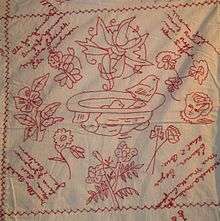Redwork

Redwork is a form of American embroidery, also called art needlework, that developed in the 19th century. It traditionally uses red thread, chosen because red dyes were the first commercially available colorfast dyes. Redwork designs are composed of simple stitches and were mainly used to decorate household objects in the 19th and 20th centuries, especially quilts. Patterns for individual quilt blocks were sold for a penny in the United States, making them popular and affordable. In the 21st century, redwork has seen a resurgence among crafters. Common themes of redwork include children, animals, and flowers.[2][3][4] The main stitch used in redwork is backstitch or outline stitching, formerly known as Kensington stitch.[5] Redwork was a common introductory form of embroidery taught to children in the 19th and 20th century.[6] It was also a way for women with skills in pattern stamping or embroidery to generate their own source of income from the home.[4][3]
References
- ↑ "Redwork | Museum Collections Up Close : MNHS.ORG". discussions.mnhs.org. Retrieved 2016-10-07.
- ↑ "America's Quilting History. Redwork Embroidery History: From Tea Towels to Quilts". Women Folk.
- 1 2 "The Deborah Harding Redwork Collection". GLQC.
- 1 2 University, MATRIX - The Center for Humane Arts, Letters, and Social Sciences Online; MSU; Michigan State (2003-10-06). "The Quilt Index". The Quilt Index. Retrieved 2016-10-09.
- ↑ "Redwork Clubs - Grandmas Attic Quilting". grandmasatticquilting.com. Retrieved 2016-10-09.
- ↑ Causee, Linda (2006-01-01). Quilts A to Z: 26 Techniques Every Quilter Should Know. Sterling Publishing Company, Inc. ISBN 9781402723186.